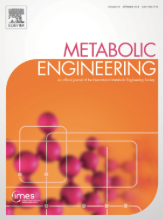| Title | Laboratory evolution reveals regulatory and metabolic trade-offs of glycerol utilization in Saccharomyces cerevisiae. |
| Year of Publication | 2018 |
| Authors | T. Strucko; K. Zirngibl; F. Pereira; E. Kafkia; E.T. Mohamed; M. Rettel; F. Stein; A.M. Feist; P. Jouhten; K.Raosaheb Patil; J. Forster |
| Journal | PLoS Comput Biol |
| Abstract | Most microbial species, including model eukaryote Saccharomyces cerevisiae, possess genetic capability to utilize many alternative nutrient sources. Yet, it remains an open question whether these manifest into assimilatory phenotypes. Despite possessing all necessary pathways, S. cerevisiae grows poorly or not at all when glycerol is the sole carbon source. Here we discover, through multiple evolved lineages, genetic determinants underlying glycerol catabolism and the associated fitness trade-offs. Most evolved lineages adapted through mutations in the HOG pathway, but showed hampered osmotolerance. In the other lineages, we find that only three mutations cause the improved phenotype. One of these contributes counter-intuitively by decoupling the TCA cycle from oxidative phosphorylation, and thereby hampers ethanol utilization. Transcriptomics, proteomics and metabolomics analysis of the re-engineered strains affirmed the causality of the three mutations at molecular level. Introduction of these mutations resulted in improved glycerol utilization also in industrial strains. Our findings not only have a direct relevance for improving glycerol-based bioprocesses, but also illustrate how a metabolic pathway can remain unexploited due to fitness trade-offs in other, ecologically important, traits. |
| PubMed ID | PubMed |
